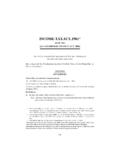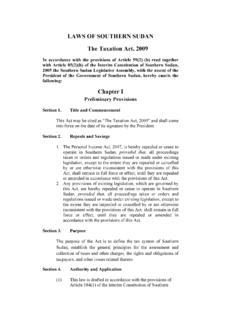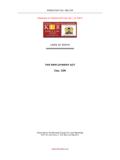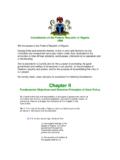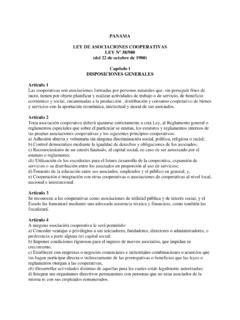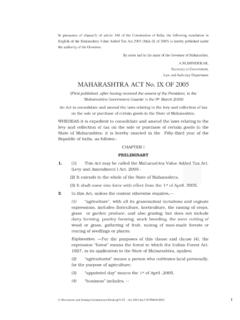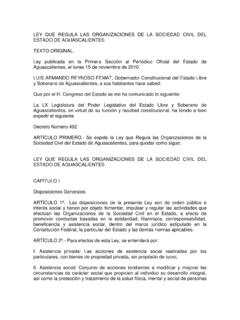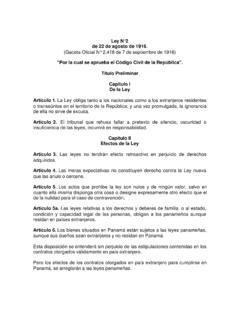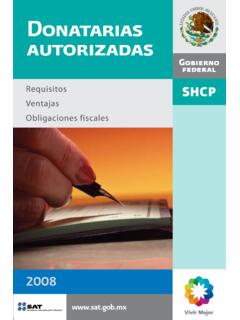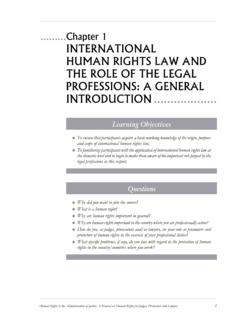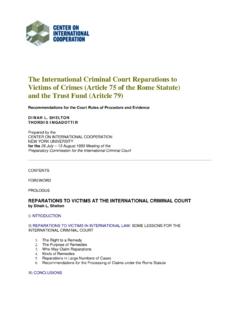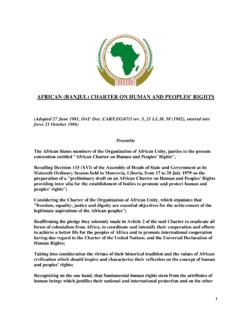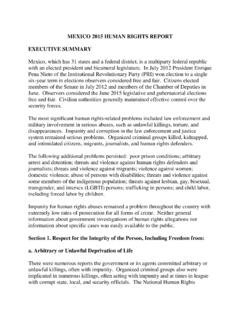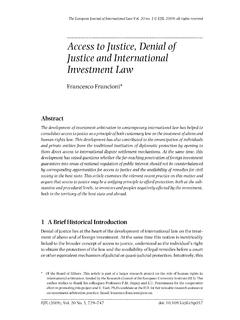Transcription of The Right to Freedom of Expression: Restrictions on a ...
1 VOLUME 6, ISSUE 1 The Right to Freedom of expression : Restrictions on a foundational Right GLOBAL TRENDS IN NGO LAW IS A PUBLICATION OF THE INTERNATIONAL CENTER FOR NOT-FOR-PROFIT LAW, AN INTERNATIONAL NOT-FOR-PROFIT ORGANIZATION THAT PROMOTES AN ENABLING ENVIRONMENT FOR CIVIL SOCIETY AND PUBLIC PARTICIPATION WORLDWIDE. SINCE ITS INCEPTION IN 1992, ICNL HAS BEEN THE WORLD S LEADING ORGANIZATION IN THE AREA OF EFFORTS TO PROMOTE PROGRESSIVE LAWS GOVERNING CIVIL SOCIETY, PROVIDING TECHNICAL ASSISTANCE TO NGO LAW REFORM INITIATIVES IN MORE THAN ONE HUNDRED COUNTRIES. WE INVITE YOU TO LEARN MORE ABOUT ICNL AND OUR PROGRAMS BY VISITING US ONLINE AT The Right to Freedom of expression : Restrictions on a foundational Right Introduction The Freedom of expression , universally acknowledged as both a fundamental and foundational human Right , is not only the cornerstone of democracy, but indispensable to a thriving civil Indeed, the Freedom of expression is considered the foundational human Right of the greatest importance.
2 2 The Right to Freedom of expression is protected by a multitude of regional and international treaties, charters, and According to Article 19(2) of the International Covenant on Civil and Political Rights (ICCPR), a formally binding legal treaty ratified by 165 nations that echoes in key respects the Universal Declaration of Human Rights (UDHR): Everyone shall have the Right to Freedom of expression ; this Right shall include the Freedom to seek, receive and impart information and ideas of all kinds, regardless of frontiers, either orally, in writing or in print, in the form of art, or through any other media of his 1 In its very first session, the UN General Assembly declared that the Freedom of Information [which inheres in the Freedom of expression ] is a fundamental human Right touchstone of all the freedoms to which the United Nations is consecrated.
3 See Resolution 59(1), 14 December 1946. According to Article 19, an organization devoted to defending the Freedom of expression , Freedom of expression is not only important in its own Right but is also essential if other human rights are to be achieved. See 2 Centre for Law and Democracy, Restricting Freedom of expression : Standards and Principles, Background Paper for Meetings Hosted by the UN Special Rapporteur on Freedom of Opinion and expression , available at 3 See , The European Convention on Human Rights, Art. 10; The American Convention on Human Rights, Art. 9; The African Charter on Human and Peoples Rights, Art. 13; The Arab Charter on Human Rights, Art. 32. 4 UN General Assembly, International Covenant on Civil and Political Rights, 16 December 1966, United Nations, Treaty Series, vol.
4 999, p. 171, available at The ICCPR in many respects mirrors the Universal Declaration of Human Rights, including in Article 19. See UN General Assembly, Universal Declaration of Human Rights, 10 December 1948, 217 A (111), available at The Freedom of expression is characterized by six key features:5 It applies to everyone equally without distinction of any kind whatsoever; distinctions based on race, colour, sex, language, religion, political or other opinion, national or social origin, property, birth or other status are entirely irrelevant to its Its geographical scope is unlimited; it applies regardless of frontiers.
5 Its substantive scope, while not unlimited, is broad; it encompasses information and ideas of all kinds. 7 It includes the rights to both receive and impart information and ideas ; the rights of both listeners and speakers, and observers and demonstrators are equally It imposes a positive obligation on signatories to the ICCPR; states are obligated to take the necessary steps to ensure its protection, including adopting laws or other measures as may be necessary and providing an effective remedy to those whose Freedom of expression has been The manner in which expressions are disseminated is unlimited; it protects the Right to impart one s ideas using any form of media of his choice.
6 The Freedom of expression , while expansive, is not absolute and can, in certain narrow circumstances, be restricted. According to Article 19(3) of the ICCPR: Because the ICCPR is considered binding, while the UDHR is not (given its nature as a non-binding General Assembly Resolution), we refer here only to the text of the ICCPR. 5 This list was inspired by a number of sources, including inter alia: Restricting Freedom of expression : Standards and Principles, Background Paper for Meetings Hosted by the UN Special Rapporteur on Freedom of Opinion and expression , Centre for Law and Democracy (2010), available at ; and Freedom of expression : Key Aspects, Article 19, available at 6 ICCPR, Art.
7 2(1). 7 Emphasis added. The UN Human Rights Committee has stressed that expression is broad and not confined to political, cultural or artistic expression , but that it also includes controversial, false and even shocking expressions. Just because an expression is disliked or thought to be false does not justify its censor without more. ICCPR, Art. 19(3) outlines the only permissible limitations. See discussion directly below on Article 19(3) and how it has been interpreted. See Article 19, Key Aspects, #3, available at 8 Italics added for emphasis. According to the Inter-American Court of Human Rights: [W]hen an individual s Freedom of expression is unlawfully restricted, it is not only the Right of that individual that is being violated, but also the Right of all others to receive information and For the average citizen it is just as important to know the opinions of others or to have access to information generally as is the very Right to impart his own opinions.
8 9 ICCPR, Art. 2(2) requires state signatories to take the necessary adopt such laws or other measures as may be necessary to give effect to the rights recognized in the present Covenant, and to provide an effective remedy to those whose freedoms have been violated. 2 [The Freedom of expression ] carries with it special duties and responsibilities. It may therefore be subject to certain Restrictions , but these shall only be such as are provided by law and are necessary: (a) For respect of the rights or reputation of others; (b) For the protection of national security or of public order (ordre public), or of public health or morals.
9 As interpreted, any limitation on the Right to Freedom of expression must meet a strict three-part test: It must be provided by law, which is clear and accessible to everyone; It must pursue one of the specific purposes set out in Article 19(3) of the ICCPR; and It must be necessary and the least restrictive means required to achieve its purported The state actor or entity imposing a limitation on free expression bears the burden of satisfying each of the three requirements. To satisfy the first requirement, the law or regulation, which should be formally adopted by law-making authorities, must be sufficiently clear and precise; vague or unclear provisions will not To meet the second requirement, only two narrowly specified aims will be considered, namely those and only those outlined in Article 19(3): national security or public order, or public health or morals.
10 This limited list of aims is designed to ensure that laws or regulations interfering with the Freedom of expression be kept to a minimum, and passed for only certain narrowly tailored, justifiable Even when justified by one of the two permissible aims stated above, such laws/regulations must be accompanied by adequate safeguards to ensure against interpretive abuse or disproportionate 10 This three-part test is common in most international and much national jurisprudence pertaining to Freedom of expression . See Defining Defamation, Principles on Freedom of expression and Protection of Reputation, July 2000, available at (see p. 4, Comment on Principle 1 ). See also Report of the Special Rapporteur on the Promotion and Protection of the Right to Freedom of Opinion and expression , Frank La Rue, Human Rights Council, May 16, 2011, at para.

